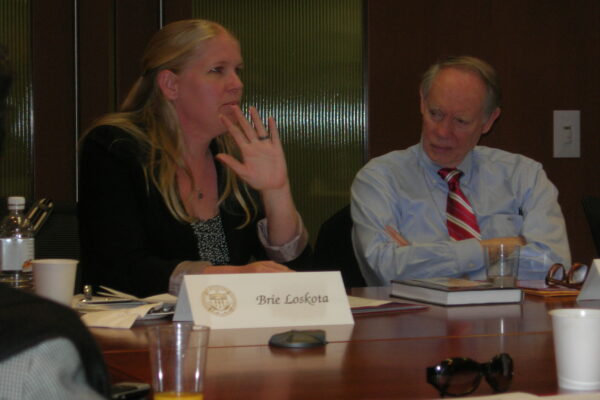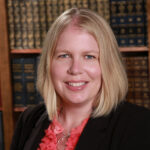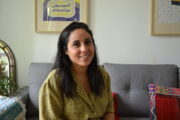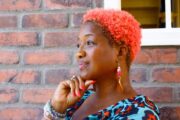Brie Loskota delivered the following remarks at a Faith and Diplomacy Briefing in Washington, D.C. on April 11, 2011. The event was sponsored by the USC Center on Public Diplomacy.
I was in Thailand in September on a trip with the Asia Foundation. In preparing for the trip, I read about a Buddhist NGO that worked during the Red Shirt protests. These individuals literally stood between the protestors and soldiers to advocate for non-violent methods of resolving disputes, using faith as their lens and motivation. And we had the opportunity to meet with some Buddhist NGO leaders engaging in this type of transformative work.
I also met with a Buddhist monk who talked about sex tourism. He explained that children born in their culture owe a debt to their parents. Boys can work off this debt by becoming monks (usually a three month process), whereas girls cannot, and they must repay their debt by financially supporting their families. This is a partial driver for Thai women to work in the sex industry. Thus, any strategy for approaching this subject, in the estimation of the monk, would require dealing with the religious issues involved.
Clearly, religion in both of these cases is a critical element of engaging complex social, political, and cultural issues. Religion can be a source of solutions to problems, even when it is also part of the cause. Any analysis of these issues that ignores religion is working with an incomplete toolkit.
In increasing ways, religion is beginning to influence the ways that public officials are thinking about the world and it is also returning to prominence as a way of viewing the American public square. In general, this is a very valuable turn of events. I don’t believe the data show that the world is becoming more religious, but we are correcting our practice of ignoring religion by paying renewed attention to it. Essentially, it is not the religious landscape that has changed, but our Western attention has been refocused.
I do think that the strict lines between secularity versus religiosity, public versus private and other binaries are beginning to blur. And the language that forces us to believe in these binaries and compartmentalize our worlds must adapt as well. Given this renewed interest in religion, and a less binary way of thinking, what does that mean, especially for public officials?
I believe that we must remember the transcendent power of religion to bridge divides and transform people’s lives. We also all know about religions darker potential. Those two elements are important to keep in mind and hold with equal tension— especially as religion gets whitewashed as only a force for good in the world, or when religions are demonized as being the source of all that is evil, or when one religious group is singled out for its supposed uniquely destructive potential.
But, we also have to think about more banal considerations when it comes to dealing with religious groups.
- How do we improve our knowledge and understanding of religions and religious individuals?
- What skills must we have in order to be effective in dealing with faith groups?
- How do we think about the different forms of religious leadership to make sure our outreach and relationships are connecting with all the various publics, not just reinforcing the status quo?
- How do we create categories and typologies to better understand the diversity within and across faith-based organizations?
- How do we evaluate this work and the impact of faith-based organizations?
- How do we figure out if faith as a factor makes a difference in effectiveness and sustainability?
So where does this renewed interest in religion come from? Generally, there are a few major trends that shape the U.S. context
- The rise of religious extremism particularly in Islamic contexts beginning in 1979 in Iran and reaching a crescendo with Sept. 11, 2001
- The growing political power of the religious right in the United States
- Charitable choice, faith based initiatives, and faith based and neighborhood partnerships programs by the last three administrations, which is, of course, partially a response to the previous point.
These trends, however, frame religion as something to be reacted against or to be harnessed. As my colleague Richard Flory said at the Center on Public Diplomacy conference at USC last month, religion is not something that for most people in the world one can abstract out from the rest of life, whether public or private.
This leads me back to my first question: how do we help diplomats and other public diplomacy actors get up to speed on religion? We need to make a distinction here between religion as a philosophical/textual/theological phenomenon and religion the way it is lived by the people who practice it. In my interactions with different agencies (and this is largely on the domestic side), I have seen in the worst cases an appalling lack of both types of understanding. Though I would say, if I had scarce resources, I would focus my energy on trying to educate officials not on the basics of theology, but on the basics of religious custom, religious authority, how religion is used, what elements of religion are most informative/authoritative in people’s lives. There is tremendous work to be done to understand “lived religion” and religion from the perspective of an insider in a particular tradition.
This leads naturally to my second question about the skills necessary to create real partnerships and relationships with people of different backgrounds. We recently worked on a program to train community organizers in different religious communities and struggled with the curriculum. The central question was, aside from knowledge about religion as I just discussed, how do we make people comfortable in various settings where they are not the majority? I had years of personal experience of this when I was the only non-Jewish graduate student at a Jewish seminary. What I learned was that this was really about soft skills- listening, reflecting, being candid, asking clarifying questions, not needing things to make sense in my worldview, being open to change, and having a real grounding in my own identity, triggers, history, etc. For most people who have been in the majority for much of their lives, learning to be the other is a powerful and transformative process. I would recommend that any effort to involve faith communities in engagement or relationship ought to begin with a serious investment in this, focusing on soft skills, personal exploration and identity so that individuals are able to be open, vulnerable and respective of each other and comfortable being different without constantly highlighting/obsessing about their differences. I would put the The Dignity of Difference by Jonathan Sacks on everyone’s reading list.
I would like to go back to my third point about engaging with different types of religious leadership. Men do much of the faith-based diplomacy at top levels with other men, and often older men. When women are included as part of religious outreach, it is often as a separate “women’s program.” While this is somewhat based on the realities on the ground—that in many areas women are excluded from traditional and official religious leadership roles— another equal reason is that we narrowly confine ourselves to accepting those roles as the most important or the most valued or most impactful. The reality of many religious traditions, even where women’s official leadership is not sanctioned, is that women play large roles in faith-based and congregational life, especially as it relates to maintaining the health and social welfare of their communities. Just as we need to understand that religion shapes much of the ways the world is experienced, so too does gender. We do a disservice to the potential power of faith-based work when we limit religious leadership to the top levels of communities and traditional positions held by men.
This is also true when we relegate our understanding of religious leadership—or leadership in general—to established, rather than emerging leaders.
One great example of both the gender and age issues was a full-page ad in a national newspaper that was titled, “We are the children of Abraham” and featured Jewish and Muslim leaders. They were all men, and also mostly older men. Apparently, Abraham, the father of nations, was exceedingly fruitful, but he had no daughters. Thus, there is a tremendous need to broaden the understanding of religious leadership to include women, both as the partners, the staffers, the board members, and advisors to this work. There is also a need to be multi-generational. Religious institutions are one of the few institutions that cut across age lines. There is tremendous power here in making sure our strategies for engagement also break age barriers, just as they need to break gender barriers.
We need to be thoughtful in the way we conceptualize religious institutions. We need good categories for thinking about the different types of organizations, the differing roles faith plays in them, their different orientations to religious authority and interpretation. Not all religious organizations, faith-based groups are created equally. This category includes storefront churches and multi-national religious NGOs. Some have a remarkable amount of technical and inter-group sophistication while others have more good intentions than actual capacity. Some are able to create long-lasting engagement that understand local cultures and norms, and others parachute in doing work that can be as disruptive as it is self-serving. So, we need to be able to talk about the range of capacities, strategies, and orientations with a great deal of nuance. In Los Angeles county alone, there are more than 6,000 congregations (and this probably excludes many storefront and informal congregations). According to National Center for Charitable Statistics, there are 8,600 faith-based groups in L.A. county. (See “Forging a New Moral and Political Agenda: The Civic Role of Religion in Los Angeles, 1992-2010,” Richard Flory, Brie Loskota, and Donald E. Miller, USC, April 2011.) Given the scale of this sector, making sweeping generalizations is a task fraught with peril.
We must also find empirical answers to a question that has a lot of assumption built in: does working with faith-groups really make a marked difference in outcomes? That frontier of research is only beginning to be explored. What we need to do in order to get there is to create and pursue robust research programs that help us segment the varieties of organizational forms, philosophies/theologies, and programs, so that we can better understand them and draw conclusions based on evidence as to how and why faith communities have or don’t have the impacts we all now feel at a gut level and know anecdotally.
Doing this and paying attention to the issues above may help us create a more full and comprehensive approach to related to individuals, groups, and issues at home and abroad, those where we find ourselves talking to others who are like us and in instances where there is a lot of difference. It may also help us maintain a bit of humility, reminding us that not only do we have something to share but we have much to learn as well.
Photo Credit: USC Public Diplomacy/Flickr
Brie Loskota is the former executive director (2016-2021) of the USC Center for Religion and Civil Culture.






